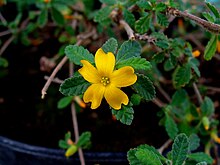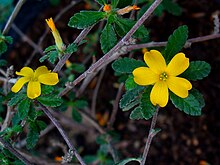Turnera diffusa
| Turnera diffusa | |
|---|---|

| |
| Turnera diffusavar.aphrodisiaca | |
| Scientific classification | |
| Kingdom: | Plantae |
| Clade: | Tracheophytes |
| Clade: | Angiosperms |
| Clade: | Eudicots |
| Clade: | Rosids |
| Order: | Malpighiales |
| Family: | Passifloraceae |
| Genus: | Turnera |
| Species: | T. diffusa
|
| Binomial name | |
| Turnera diffusa | |
| Varieties[2] | |
|
T. d.var.aphrodisiaca(G.H.Ward)Urb. | |
| Synonyms[3] | |
|
List
| |


Turnera diffusa,known asdamiana,[4]is ashrubnative to southernTexasin the United States,[5]Mexico, Central America, South America, and the Caribbean. It belongs to the familyPassifloraceae.[2]
Damiana is a relatively small, woody shrub that produces small, aromatic flowers. It blossoms in early to late summer, followed by fruits that taste similar to figs. The shrub is said to have a strong spice-like odor somewhat likechamomile,due to the aromatic compounds present in the plant.[6]
Uses
[edit]Damiana is an ingredient in a traditionalMexicanliqueur,which is sometimes used in lieu oftriple secinmargaritas.Mexican folklore claims that it was used in the "original" margarita. The damiana margarita is popular in theLos Cabosregion of Mexico.[7][8]
Damiana was included in several 19th-centurypatent medicines,such asPemberton's French Wine Coca.The leaves were omitted from that product's non-alcoholic counterpart,Coca-Cola.[9]In folklore, the plant was believed to be an aphrodisiac, hence its sometimes used binomial synonym,Turnera aphrodisiaca.
Phytochemistry
[edit]Damiana contains damianin; tetraphyllin B; gonzalitosin I;arbutin;tricosan-2-one;acacetin;p-cymene;β-sitosterol;1,8-cineole;apigenin;[10]α-pinene;β-carotene;β-pinene;tannins;thymol;[11]andhexacosanol.[12]In total, 22flavonoids,maltolglucoside,phenolics,sevencyanogenic glycosides,monoterpenoids,sesquiterpenoids,triterpenoids,the polyterpene ficaprenol-11,fatty acids,andcaffeinehave been found in the genusTurnera.[13]As of 2006, damiana's constituents have not been identified for their effects attributed to the whole herb.[14]Damiana'sanxiolyticproperties might be due toapigenin.[12]The extract from damiana has been found to suppressaromatase activity,including the isolated compoundspinocembrinandacacetin.[15][16]
Ecology
[edit]T. diffusais a host plant for the Mexican fritillary (Euptoieta hegesia), a butterfly.[17]
Misidentification in commerce
[edit]Viable plant and seed material sold asT. diffusafrom both private and commercial sources largely turns out to be misidentifiedTurnera ulmifolia(a.k.a. "False Damiana" ), a closely related species. This widespread issue has been noted by the scientific community, and has created much confusion among both amateur and professional horticulturists alike.[18][19][20]WhileT. ulmifoliaare similar in appearance, it's chemical constituents and ethnobotanical uses are distinctly different.[21]Mature stems ofT. diffusaare woody, with small, grayed green leaves 13 to 16 mm long, 4.5 to 5.5 mm wide, obtuse at the apex, and strongly aromatic when crushed.[22]T. ulmifoliais differentiated by herbaceous stems, larger blue-green leaves that are strongly dentate with a pointed apex, and only weakly aromatic.[23][24][25]One scientific study however, demonstrated this confusion being mostly associated with horticultural commerce, and does not extend appreciably to commercial herbal products, most of which exhibit constituents that can be definitively traced toT. diffusa.[26]
References
[edit]- ^"Turnera diffusa".Integrated Taxonomic Information System.Retrieved2011-01-29.
- ^ab"Turnera diffusa".Germplasm Resources Information Network.Agricultural Research Service,United States Department of Agriculture.Retrieved2012-01-03.
- ^"Turnera diffusaWilld. ex Schult ".Plants of the World Online.Board of Trustees of the Royal Botanic Gardens, Kew. 2017.Retrieved4 September2020.
- ^USDA, NRCS(n.d.)."Turnera diffusa".The PLANTS Database (plants.usda.gov).Greensboro, North Carolina: National Plant Data Team.Retrieved12 December2015.
- ^Everitt, J. H.; Dale Lynn Drawe; Robert I. Lonard (2002).Trees, Shrubs, and Cacti of South Texas.Texas Tech University Press. p. 208.ISBN978-0-89672-473-0.
- ^Gildemeister, Eduard; Friedrich Hoffmann (1922). Edward Kremers (ed.).The Volatile Oils.Vol. 3 (2 ed.). Wiley. p. 183.
- ^"Damiana Liqueur at Damiana.net".Archived fromthe originalon 2018-02-28.Retrieved2007-04-10.
- ^Perry, Charles (2007-06-20)."The unexpected thrill".Los Angeles Times.
- ^Pendergrast, Mark(2000).For God, Country, and Coca Cola: The Definitive History of the Great American Soft Drink and the Company That Makes It(2 ed.). Basic Books. pp.24–30.ISBN978-0-46505-468-8.
- ^Kumar, Suresh (February 9, 2005)."Anti-anxiety Activity Studies on Homoeopathic Formulations of Turnera aphrodisiaca Ward".Evid Based Complement Alternat Med.2(1). Hindawi Publishing Corporation: 117–119.doi:10.1093/ecam/neh069.PMC1062162.PMID15864356.
- ^Balch, Phyllis A. (2002).Prescription for Nutritional Healing: the A to Z Guide to Supplements(2 ed.). Penguin. p.233.ISBN978-1-58333-143-9.
- ^abKumar, S; Madaan, R; Sharma, A (2008), "Pharmacological evaluation of Bioactive Principle of Turnera aphrodisiaca",Indian Journal of Pharmaceutical Sciences,70(6): 740–4,doi:10.4103/0250-474X.49095,PMC3040867,PMID21369434
- ^Szewczyk, K; Zidorn, C (2014). "Ethnobotany, phytochemistry, and bioactivity of the genus Turnera (Passifloraceae) with a focus on damiana – Turnera diffusa".Journal of Ethobotany.152(3): 424–443.doi:10.1016/j.jep.2014.01.019.ISSN0378-8741.PMID24468305.
- ^Kumar, Suresh; Taneja, Ruchi; Sharma, Anupam (2006), "Pharmacognostic Standardization of Turnera aphrodisiaca Ward",Journal of Medicinal Food,9(2): 254–60,doi:10.1089/jmf.2006.9.254,PMID16822212
- ^Zhao J, Dasmahapatra AK, Khan SI, Khan IA (2008). "Anti-aromatase activity of the constituents from damiana (Turnera diffusa)".Journal of Ethnopharmacology.120(3): 387–393.doi:10.1016/j.jep.2008.09.016.PMID18948180.
- ^Katarzyna Szewczyka; Christian Zidorn (2014). "Ethnobotany, phytochemistry, and bioactivity of the genus Turnera (Passifloraceae) with a focus on damiana—Turnera diffusa".Journal of Ethnopharmacology.152(3): 424–443.doi:10.1016/j.jep.2014.01.019.PMID24468305.
- ^Wauer, Roland H. (2004).Butterflies of the Lower Rio Grande Valley.Boulder, CO: Johnson Books. p. 128.ISBN9781555663476.
- ^Joshi, V.C.; Rao, A.S.; Wang, Y.H.; Avula, B.; Khan, I.A. (March 2009)."Taxonomic Clarification on Turnera diffusa Ward and its Demarcation from" False Damiana "using Fluorescence, Scanning Electron Microscopy, HPTLC and UPLC".Planta Medica.75(4).doi:10.1055/s-2009-1216454.
- ^"Damiana - Turnera diffusa, Turnera ulmifolia seed pictures".shroomery.org.Retrieved7 September2016.
- ^"Turnera diffusa var diffusa or var aphrodisiaca or what?".National Gardening Association.Retrieved7 September2016.
- ^"Tropical Plant Database".Raintree.Retrieved7 September2016.
- ^Meerow, Alan W.; Ayala-Silva, Tomás; Irish, Brian M. (December 2010)."Turnera diffusa 'Luisa', a Drought-tolerant Small Shrub for Warm Climates".HortScience.45(12): 1895–1896.doi:10.21273/HORTSCI.45.12.1895.
- ^"Elm-leaved Turnera – Turnera ulmifolia".A Neotropical Savanna.Retrieved7 September2016.
- ^"Turnera Ulmifolia".College of Micronesia.Retrieved7 September2016.
- ^"Woody and Herbaceous Plants Native to Haiti"(PDF).University of Florida, Miami-Dade.Retrieved7 September2016.
- ^Schäffer, Marion; Gröger, Thomas; Pütz, Michael; Zimmermann, Ralf (July 2013)."Assessment of the presence of damiana in herbal blends of forensic interest based on comprehensive two-dimensional gas chromatography".Forensic Toxicology.31(2): 251–262.doi:10.1007/s11419-013-0186-5.S2CID21030359.Retrieved7 September2016.
